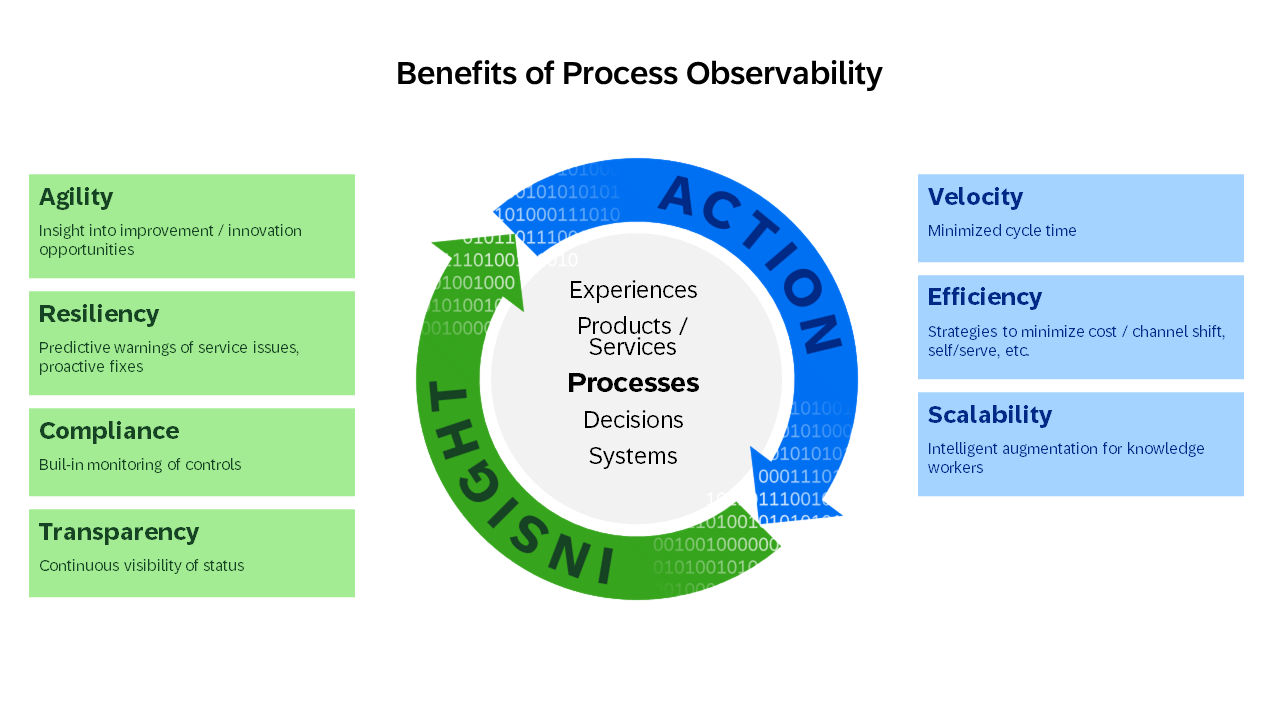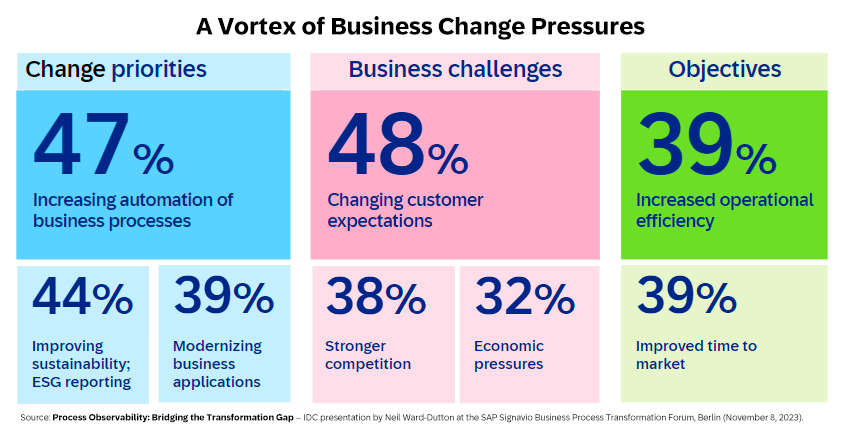What if you could not only monitor every part of your business in real time but also predict challenges before they arise? Today’s fast-paced market requires a 360-degree view of operations to stay ahead of the competition and drive growth. In a recent SAP Signavio solutions webcast, Oliver Joeres from Hilti and Neil Ward-Dutton from IDC explored the transformative impact of AI on enterprise observability and the benefits for organizations.
In ancient times, the Roman Empire’s borders stretched across more than 20 present-day countries and three continents. To continually protect such a massive territory, the Romans introduced a border defense mechanism called the watchtowers—tall structures placed strategically across provincial borders. Using these watchtowers, sentinels could monitor the surrounding area and alert troops at the first sign of invasion.
Likewise, in modern day times, organizations are constantly looking for ways to stay ahead of competition, protect market share, and generally drive business growth. Digital transformation isn’t just another buzzword, it’s a necessity. And at the heart of this transformation is enterprise observability, a concept that allows companies to gain a 360-degree view—like the watchtower—of their operations and processes.
Let’s call it your digital watchtower.
As an industry leader at the helm of your company, you’re tasked with overseeing complex operations from managing customer orders to maintaining supply chains. Imagine if you could see everything happening in your business, understand why it’s happening, and predict what will happen next, all in real time. That’s the magic of enterprise observability.
But how exactly does this work, and how can artificial intelligence (AI) take it even further? Let’s explore.
What is enterprise observability?
Enterprise observability is having the ability to monitor and analyze every aspect of your organization—people, processes, data, and applications—through a single integrated system. This means you can see everything from how your customers are interacting with your products to the performance of your IT infrastructure. Think of it as putting on a pair of high-tech glasses that allow you to see not just what’s happening across your company but why it’s happening and, more importantly, how to improve it.
At its core, enterprise observability is more than just monitoring individual processes. It’s about creating a holistic view of your entire organization—processes, people, and systems—all in real time.
Process observability, a spin-off of enterprise observability, focuses on understanding the health and performance of your business processes. Whether it's invoicing, order fulfilment, or customer service, process observability ensures that your internal operations run smoothly and efficiently.
However, the true magic happens when AI steps in to extend these capabilities.
How AI can help increase process observability
While traditional performance management tools give you insights into your enterprise by monitoring system performance, AI goes a step further. It doesn’t just monitor processes, it analyzes data, identifies patterns and why bottlenecks happen, and suggests predictive actions to prevent issues from recurring or to address them before they escalate. By leveraging the possibilities with AI, you can quickly analyze huge data sets, identify bottlenecks, and implement solutions that improve the ultimate customer experience.
Five ways enterprise observability and AI can help drive unmatched business growth
Just like the Roman watchtowers provided an early warning system to protect the empire, enterprise observability serves as a modern-day sentinel for organizations navigating the complexities of digital transformation. But the real power of enterprise observability lies in its ability to elevate decision-making and streamline operations. When combined with AI, its benefits are far-reaching, especially for business leaders.

Smarter decisions on the go
In digital transformation, timing is everything. The ability to make real-time, data-driven decisions can mean the difference between gaining a competitive edge or falling behind. Enterprise observability offers a unified view of all your operational data across processes, departments, and systems. This ensures that leaders have the information they need at their fingertips, allowing for quicker and more informed decision-making. AI enhances this by spotting patterns and providing actionable insights faster than human analysis can achieve.
More proactivity, less reactivity
While traditional monitoring might alert you to problems as they arise, AI-driven observability takes things a step further by identifying issues before they impact your business. AI can analyze vast amounts of data from multiple sources and predict potential bottlenecks or risks, allowing you to address them proactively, such as through predictive maintenance, supply chain optimization, quality control, scheduling, and retooling. With AI predictive analysis, you're not just reacting to problems, you're preventing them from occurring in the first place.
The ultimate customer experience
Enterprise observability can help companies to fine-tune their internal operations for a seamless customer journey. AI helps optimize processes such as order fulfilment, invoicing, and service delivery, ensuring minimal friction and delays. In the webinar, Oliver Joeres, head of business process excellence, technologies, and methods at Hilti, emphasizes that today’s customers expect not only top-quality products but also outstanding experiences. To meet these expectations, Hilti has implemented an "experience-driven process management" approach. This strategy focuses on essential customer journeys, such as order-to-payment and repair processes, to ensure a smooth, seamless experience at every interaction.
Greater agility in digital transformations
Digital transformations often face challenges due to the complexity of data integration and change management. According to IDC research, “The variety of software-as-a-service (SaaS) applications is burgeoning. More than half of companies use more than 50 SaaS applications—and around 30% use more than 100”.

Not to mention data overload, where information in many organizations exists in silos or scattered across different platforms. Enterprise observability simplifies this by providing a holistic view, enabling leaders to see how different parts of the organization interact and identify areas where changes can be made with minimal disruption.
When combined with AI, process observability can help organizations achieve greater agility. By pulling together disparate data sources, AI speeds up the process of identifying inefficiencies and opportunities for improvement with minimal disruption.
Driving innovation through continuous improvement
One of the most rewarding benefits of enterprise observability is its ability to create a culture of continuous improvement. By constantly monitoring processes and using AI to analyze performance data, companies can uncover new opportunities for innovation. Whether it’s automating routine tasks, improving employee productivity, or discovering untapped market potential, AI combined with enterprise observability can empower organizations to keep evolving. Leaders can rely on real-time insights to make incremental improvements that drive both operational efficiency and long-term innovation.
Ready to unlock deeper insights and streamline collaboration in your organization?
Download our Info Snapshot, “Maximize Business Performance with Enterprise Observability,” to explore how SAP solutions can support your digital transformation with actionable data and smooth process integration.




